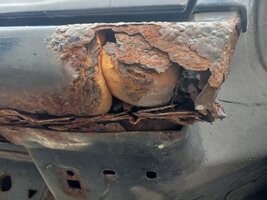You are using an out of date browser. It may not display this or other websites correctly.
You should upgrade or use an alternative browser.
You should upgrade or use an alternative browser.
What do y’all think about filling your TJ frame with expandable foam to keep out salt, dirt and water to prevent rust? Any downside to this?
I think it would be too easy to trap moisture and could accelerate rust.
Any downside to this?
That's a terrible idea. No upside, all down. Those foams are generally open cell and are virtually a sponge which hold water. Even if you used closed cell foam, it would create voids and pockets that would trap dirt and moisture. You can see this in many houses if you look around. Lots of rot damage is caused by spray foams.
It would undoubtably act like a sponge. I have seen where idiots used it for body repairs, and it holds everything you are trying to exclude, and just dissolves the metal at an accelerated rate.
P
P man
Guest
Sounds like one hell of a stupid idea
So Chris, who's burner account is it?
Perhaps someone should ask ChatGPT...
P
P man
Guest
So Chris, who's burner account is it?Is it Boogie? He's always talking about rust, and new wives, and biden... I'm pretty sure bad idea fits in there somewhere.

I dont think it's a joke I have seen this come up a few times over the years
Had a fuel tank bedded in poured foam on a boat. Of course the tank leaked. When I pulled the tank the bottom against the foam had completely disappeared because of corrosion.
Had a fuel tank bedded in poured foam on a boat.
Lots of smaller boats, I think it's 29' and under, with the required flotation foam have significant rot issues after a decade or so. Rotten transoms and soft spots in the floor are common due to the moisture held by the foams, even though closed cell is used.
Some OEMs will do this to stiffen car bodies and cut down on noise. However, they use a 2-part closed cell low pressure foam, usually with a relatively high density. Very different than insulating foam.
Some OEMs will do this to stiffen car bodies and cut down on noise. However, they use a 2-part closed cell low pressure foam, usually with a relatively high density. Very different than insulating foam.
Are the bodies also coated/dipped before applying the foam?
LONGJP2
TJ Expert
Spray foam is strangely popular with meth heads. You don't want people thinking you use meth.
Instead, fill the frame with quickcrete. Much stronger.
Instead, fill the frame with quickcrete. Much stronger.
What do y’all think about filling your TJ frame with expandable foam to keep out salt, dirt and water to prevent rust? Any downside to this?
clean the frame out and use Eastwood's internal frame coating:
https://www.eastwood.com/eastwood-internal-frame-coating-14oz-aerosol.html
Are the bodies also coated/dipped before applying the foam?
It depends. Usually it is only done in unibody vehicles, or in the body only of a body-on-frame vehicle. So the exposure to salt spray is less than a typical frame sees.
Generally there is some sort of coating, or the foam mixture has a low enough viscosity to flow into every crevice and act as a sealant by itself.


